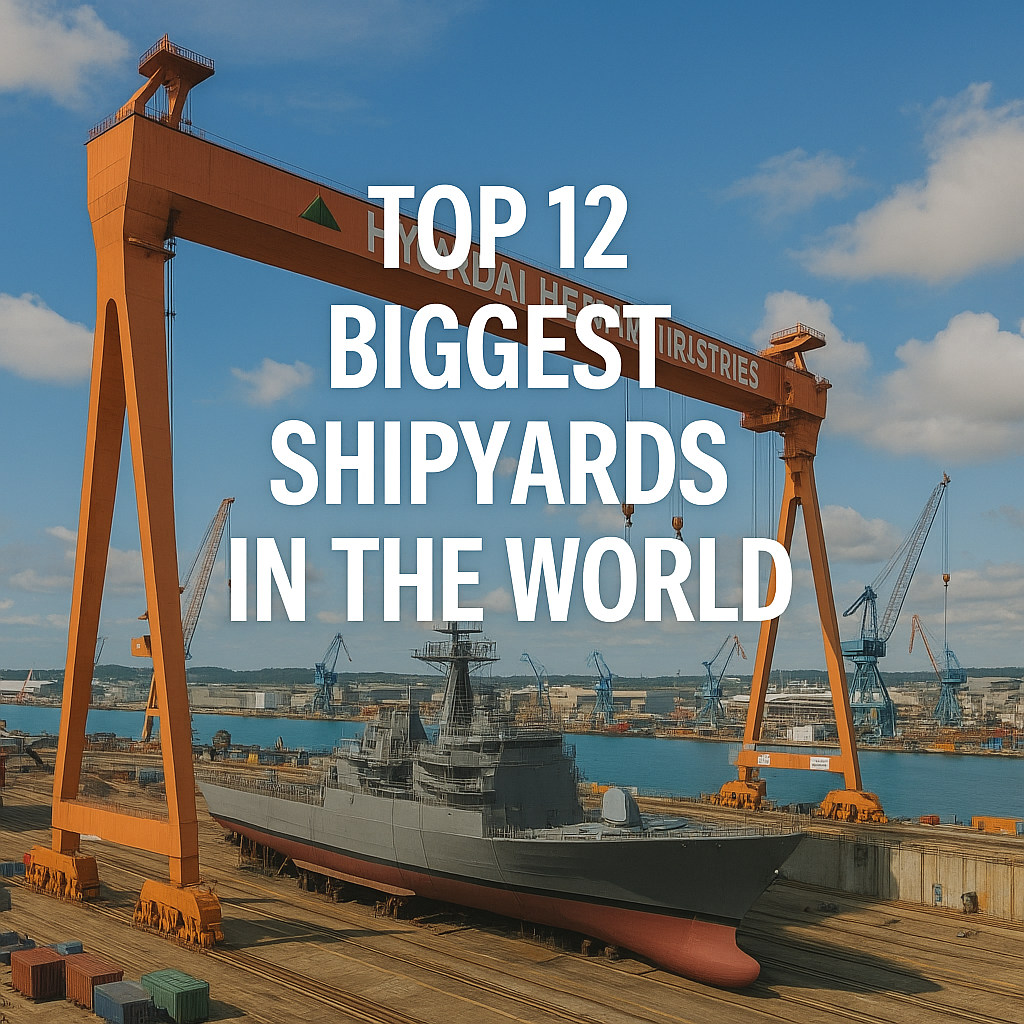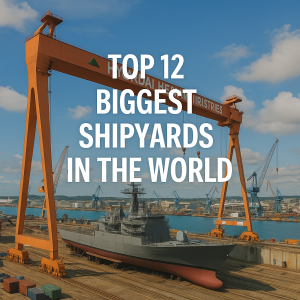Explore the top 12 biggest shipyards in the world by capacity, output, and technological innovation. Learn how these giants shape global shipbuilding trends and maritime sustainability.
Why Shipyards Matter in Modern Maritime Operations
Shipyards are the industrial backbone of the maritime world. From ultra-large container vessels (ULCVs) to LNG carriers and naval warships, the biggest shipyards construct the floating assets that drive 90% of global trade. As maritime logistics evolve—driven by digitalization, decarbonization, and defense modernization—the role of these massive facilities has become more strategic than ever.
According to the International Maritime Organization (IMO) and UNCTAD, over 60,000 commercial ships operate worldwide. Many of these vessels are designed and constructed in just a handful of colossal shipyards, particularly in East Asia. These shipyards are not only production centers but also testbeds for green shipping, autonomous technologies, and cybersecure design.
In this article, we explore the 12 biggest shipyards globally, ranked by metrics such as gross tonnage output, dock size, global market share, and technological capability—supported by authoritative sources like Lloyd’s List Intelligence, IHS Markit, and DNV.
1. Hyundai Heavy Industries (HHI) – Ulsan, South Korea
Annual Capacity: ~12 million GT
Dock Size: World’s largest dry dock (672m x 92m)
Hyundai is a global leader in shipbuilding and offshore engineering. The shipyard produces everything from LNG carriers and VLCCs to naval destroyers and smart ships. Its HiMSEN engines and eco-ship designs meet IMO Tier III and EEDI Phase 3 standards.
Tech Highlights:
- AI-driven design tools
- Autonomous ship R&D with Avikus
Website: hhi.co.kr
2. China State Shipbuilding Corporation (CSSC) – Shanghai & Guangzhou, China
Annual Output: >20% of global ship orders (combined yards)
CSSC oversees multiple facilities including Jiangnan Shipyard, Hudong-Zhonghua, and Shanghai Waigaoqiao Shipbuilding. It leads in the construction of dual-fuel LNG vessels, VLCCs, and military ships including China’s aircraft carriers.
Recent Milestone:
Delivered Asia’s first large cruise ship in 2023
Website: en.cssc.net.cn
3. Daewoo Shipbuilding & Marine Engineering (DSME) – Geoje, South Korea
Annual Capacity: ~7 million GT
Specialty: LNG carriers, FPSOs, submarines
DSME’s shipyard at Okpo Bay is known for building ultra-complex, high-spec vessels. It is a world leader in floating LNG platforms and recently delivered ice-class tankers for Arctic operations under the Yamal LNG project.
R&D Focus:
Integrated bridge systems, AI-based route optimization, and LNG propulsion
Website: dsme.co.kr
4. Samsung Heavy Industries (SHI) – Geoje, South Korea
Annual Capacity: ~5 million GT
SHI builds high-tech LNG carriers, oil platforms, and containerships. It is also a key player in maritime digitalization, having developed IntelliMan, a ship performance management system in collaboration with Wärtsilä.
Sustainability Note:
Developing ammonia-fueled ships and autonomous navigation software
Website: samsungshi.com
5. Imabari Shipbuilding – Marugame, Japan
Annual Capacity: ~3 million GT
Japan’s largest shipbuilder and a major exporter, Imabari operates over 10 yards and co-owns Japan Marine United. It builds ULCVs and eco-bulk carriers with ballast water treatment systems and EEDI compliance.
Recent Expansion:
Built the 400-meter-long ONE Innovation, one of the largest boxships globally
Website: imabariship.co.jp
6. Fincantieri – Trieste, Italy
Annual Revenue: €7.4 billion (2023)
Specialization: Cruise ships, naval vessels, and offshore units
Europe’s top shipbuilder, Fincantieri operates 18 yards globally and builds for Carnival, MSC, and the Italian Navy. It also leads innovation in hydrogen fuel cells and electric propulsion.
Notable Projects:
FREMM frigates, luxury mega yachts, and autonomous naval vessels
Website: fincantieri.com
7. Japan Marine United (JMU) – Tokyo, Japan
Output: Major bulk carriers and LNG-powered ferries
Formed by merging IHI Marine and Universal Shipbuilding, JMU focuses on technologically advanced ships, including LNG carriers, MR tankers, and wind-assisted propulsion designs.
Innovation:
Wing-sail cargo ship concepts and ClassNK-certified emissions software
Website: jmu.co.jp
8. Yangzijiang Shipbuilding – Jiangsu, China
Capacity: Over 2.5 million GT annually
A private-sector giant, Yangzijiang builds a range of vessels including container ships, multipurpose vessels, and green bulkers. It’s at the forefront of LNG dual-fuel ship development in China’s private sector.
Tech Leap:
Partnership with Wärtsilä for hybrid propulsion systems
Website: yzjship.com
9. Oshima Shipbuilding – Nagasaki, Japan
Specialty: Bulk carriers and eco-designs
Oshima is known for environmental performance and builds some of the world’s most fuel-efficient Handymax and Panamax vessels. Its collaboration with DNV on GHG modeling has been recognized globally.
Focus:
Low-friction coatings, hull shape optimization
Website: oshimashipyard.com
10. Mitsubishi Heavy Industries – Nagasaki & Kobe, Japan
Legacy: Shipbuilding, aerospace, and defense integration
MHI is not just a shipbuilder but an engineering giant. Its yards produce ferries, LNG carriers, and defense vessels. It also contributes to offshore wind platforms and modular floating ports.
Highlight:
First Japanese builder to use air lubrication systems on containerships
Website: mhi.com
11. Mazagon Dock Shipbuilders – Mumbai, India
Specialty: Submarines and naval vessels
India’s largest defense shipyard builds Scorpène-class submarines, frigates, and destroyers. It has expanded to include green shipbuilding aligned with India’s maritime decarbonization plans.
Global Engagement:
Partnership with French Naval Group and Russian design bureaus
Website: mazagondock.in
12. Chantiers de l’Atlantique – Saint-Nazaire, France
Specialty: Cruise ships and LNG fuel systems
Best known for mega-cruise ships for Royal Caribbean and MSC, this yard integrates LNG propulsion and smart energy grids onboard. It also supports France’s naval and renewable marine energy projects.
Sustainability Achievement:
Constructed the MSC World Europa—one of the cleanest cruise ships to date
Website: chantiers-atlantique.com
–
Case Study: LNG Shipbuilding at DSME
DSME has led LNG shipbuilding for over a decade. Its NO96 and Mark III membrane systems, developed with GTT, are used globally. With an LNG fleet portfolio exceeding 150 vessels, DSME also deploys AI for cargo boil-off reduction, advancing both efficiency and environmental compliance under MARPOL Annex VI and IMO 2023.
Key Technologies & Developments Driving Change
1. Green Propulsion
-
LNG, ammonia, hydrogen, and battery-electric propulsion systems
-
Supported by Wärtsilä, Alfa Laval, and ClassNK for performance certification
2. Smart Shipyards
-
Digital twins, robotic welding, and AI-powered QA systems
-
Already operational at HHI, SHI, and Fincantieri
3. Decarbonization Compliance
-
Shipyards now design vessels to meet EEDI Phase 3, CII, and Tier III NOx limits
-
DNV and ABS audit eco-designs pre-launch
FAQ
1. What’s the largest shipyard in the world?
Hyundai Heavy Industries (HHI) in Ulsan, South Korea holds that title in terms of area and production capacity.
2. Which shipyards lead in LNG carrier construction?
DSME, SHI, and Hudong-Zhonghua dominate LNG shipbuilding globally.
3. Are shipyards building ammonia- or hydrogen-fueled ships?
Yes, pilot projects at Samsung Heavy, Fincantieri, and Japan Marine United are already underway.
4. How do shipyards ensure environmental compliance?
They follow IMO rules (MARPOL Annex VI, CII) and certifications from class societies like DNV and Lloyd’s Register.
5. Which yards focus on military ships?
HII, Fincantieri, DSME, and Mazagon Dock are key in defense naval construction.
6. Are autonomous ships being built at these shipyards?
Yes. HHI, Samsung, and Fincantieri are developing autonomous and remote-operated vessels using AI and sensor fusion.
Conclusion
The world’s biggest shipyards are no longer just industrial giants—they are incubators of innovation, guardians of maritime security, and pioneers in sustainability. As the industry transitions toward decarbonization and digitalization, these shipyards are setting global standards for smart and green ship construction.
Call to Action:
Whether you’re a maritime professional, student, or policymaker, follow these shipyards’ advancements to understand the future of global shipping and sustainability.
References
-
IMO – https://www.imo.org
-
UNCTAD Maritime Review 2024 – https://unctad.org
-
DNV Green Ship Design – https://www.dnv.com/maritime
-
Wärtsilä – https://www.wartsila.com
-
IHS Markit/S&P Global Shipbuilding Report – https://ihsmarkit.com
-
HHI – https://www.hhi.co.kr
-
Fincantieri – https://www.fincantieri.com
-
Chantiers de l’Atlantique – https://www.chantiers-atlantique.com


